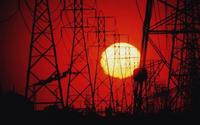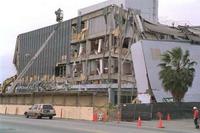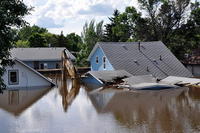-
Limitations and side effects of large-scale geoengineering
Despite international agreements on climate protection and political declarations of intent, global greenhouse gas emissions have not decreased, and with the accelerating industrialization of emerging markets, are not likely to any time soon. Therefore, large-scale methods – called geoengineering or climate engineering — artificially to slow down global warming are increasingly being discussed. Scientists say that the long-term consequences and side effects of these methods have not been adequately studied.
-
-
Damage to coastal infrastructure from storm surges, floods may reach 9% of global GDP
Damage to the world’s coastal infrastructure as a result of flooding, sea level rise, and coastline development is expected to cost as much as 9 percent of global Gross Domestic Product (GDP) according to a new report published in the Proceedings of the National Academy of Sciences(PNAS).
-
-
Studying the 2011 Mississippi and Ohio rivers flood for better flood preparedness
In May 2011, when the U.S. Army Corps of Engineers used explosives to breach a levee south of Cairo, Illinois, diverting the rising waters of the Mississippi and Ohio rivers to prevent flooding in the town, about 130,000 acres of Missouri farmland were inundated. It was the largest flood of the lower Mississippi ever recorded. Researchers took advantage of this “once-in-a-scientific-lifetime” occurrence to study the damage in order to demonstrate that landscape vulnerabilities can be mapped ahead of time to help communities prepare for extreme flooding.
-
-
Implementing solar radiation management, then stopping, would accelerate climate change
One geoengineering approach to slowing or reversing climate change is solar radiation management, which envisions spraying tiny sulfur-based particles into the upper atmosphere to reflect sunlight. This is similar to what happens after a major volcanic eruption, and many experts believe the technique is economically and technically feasible. Continuous implementation over years, however, depends on technical functioning, continuous funding, bureaucratic agreement, and lack of negative side effects. In a new study, researchers say that spraying reflective particles into the atmosphere to reflect sunlight and then stopping it could exacerbate the problem of climate change.
-
-
Fashioning an effective disaster mitigation approach in an uncertain world
The dramatic images of natural disasters show that nature, not the people preparing for hazards, often wins the high-stakes game of chance. Sometimes nature surprises us when an earthquake, hurricane, or flood is bigger or has greater effects than expected. In other cases, nature outsmarts us, doing great damage despite expensive mitigation measures or causing us to divert limited resources to mitigate hazards that are overestimated. Much of the problem comes from the fact that formulating effective natural hazard policy involves combining science, economics, and risk analysis to analyze a problem and explore costs and benefits of different options in situations where the future is very uncertain.
-
-
Power cuts will be more common in the future

U.S. figures show that since 2007, commercial and domestic air-conditioning alone consumed 484billion kilowatt hours of electricity — not much more than the country’s total energy consumption in the mid-1950s. The American Society of Civil Engineers (ASCE) has warned that U.S. generation systems could collapse by 2020 without $100 billion of new investment in power stations. Demands of high-powered electrical appliances, a growing world population, and inadequate investment in the power sector will create more frequent power blackouts in Western societies.
-
-
Protecting Earth from menacing asteroids
Tracking near-Earth asteroids has been a significant endeavor for NASA and the broader astronomical community, which has discovered 10,713 known near-Earth objects (NEO) to date. NASA says that it is now pursuing new partnerships and collaborations in an Asteroid Grand Challenge to accelerate NASA’s existing planetary defense work, which will help find all asteroid threats to human population and know what to do about them. In parallel, NASA is developing an Asteroid Redirect Mission (ARM) — a first-ever mission to identify, capture, and redirect an asteroid to a safe orbit of Earth’s moon for future exploration by astronauts in the 2020s.
-
-
Santa Monica to identify, require retrofitting for, quake-vulnerable buildings

Twenty years ago the city of Santa Monica, California passed laws requiring retrofitting of concrete, steel, and wood apartment buildings which were likely to collapse during an earthquake. The city stopped enforcing the laws a few years after it was passed. Beginning this year, Santa Monica will inspect, and require seismic retrofitting for, concrete, steel, and wood-frame buildings deemed vulnerable during a major earthquake.
-
-
Costs of extreme weather events multiply

The United States sustained $1.15 trillion in economic loss in the past thirty years due to extreme weather, a trend that will continue if state and local governments do not prepare for future weather disasters, according to Munich Re, the world’s largest risk insurer.The GAO’s Mark Gaffigan told lawmakers that as a result of extreme weather, the federal government’s crop insurance program had increased four-fold since 2003, and the flood insurance program has a $24 billion debt.
-
-
Long-term perspective on food security and climate shock
What role do pre-existing vulnerabilities play for people who experience a climate shock? Do these vulnerabilities amplify the effects of the climate shock or is effect negligible? Four Arizona State University archaeologists are looking into this as part of an international team examining how people can be most resilient to climate change when it comes to food security.
-
-
Torrential rain, hurricane-force winds, floods continue to batter U.K.
Torrential rains, floods, and winds with speeds reaching 108 mph continue to batter south and west U.K., causing massive disruptions to power supply and road and rail transportation. Britain is enjoying a short respite today (Thursday), but meteorologists warned people to brace themselves for more chaos as another storm brings heavy rain, strong winds, and more risk of flooding on Friday and into the weekend. Severe flood warnings, indicating danger to life, remain in place in Berkshire, Surrey, and Somerset, where hundreds of homes have been evacuated.
-
-
W.Va. spill leads lawmakers, industry to look at reforming toxic substances law
The government was slow to respond to the 9 January 2014 massive chemical spill in West Virginia because the law governing such response, the 1976 Toxic Substances Control Act (TSCA), limits regulatory agencies’ authority to investigate such spills.Under TSCA, the EPA must first prove that a chemical poses an unreasonable risk to health or the environment before it can require the needed testing that would show a potential risk. One observer called this a Catch-22, telling a congressional panel that “This is like requiring a doctor to prove that a patient has cancer before being able to order a biopsy.”
-
-
U.S. takes action against tank car loaders for mislabeling hazardous cargo
One of the charges against Montreal Maine & Atlantic Railway (MMAR), the rail carrier operating the train which exploded in the small city of Lac- Mégantic, Quebec in July 2013, was that it mislabeled the cargo, claiming it to be less hazardous than it was. The mislabeling and downgrading of the contents of the cars allowed to company to take less rigorous security measures to secure the cars without appearing to break the law. The U.S. Department of Transportation (DOT) is moving against other carriers who mislabel the contents of their cargo to avoid the cost of required security measures.
-
-
Floods caused lead poisoning in U.K. cattle
Massive floods in England and Wales have forced thousands to evacuate their homes and destroyed railways and roads. Scientists say the U.K. floods of recent years carry yet another danger with them: lead poisoning. Silage cut from fields soon after they were inundated in the 2012 floods and then fed to cattle raised the lead levels in the animals, killing some of them. Blood samples taken from cattle showed that all of them had lead levels beyond the safe limit for human consumption. An autopsy carried out on one of the casualty animals found lead concentrations 79 times the safe level in its kidney. The contaminated material is thought to originate from historical metal mining in the area. Scientists say a number of river catchments throughout England and Wales face a similar risk.
-
-
Natural gas leaks a significant source of green-house gas methane

Methane, a key greenhouse gas, has more than doubled in volume in Earth’s atmosphere since 1750. Its increase is believed to be a leading contributor to climate change. Where is the methane coming from, however? Research by atmospheric chemist Paul Wennberg of the California Institute of Technology (Caltech) suggests that losses of natural gas – regarded as the “cleanest” fossil fuel — into the atmosphere may be a larger source than previously recognized.
-
More headlines
The long view
Trump Aims to Shut Down State Climate Policies
President Donald Trump has launched an all-out legal attack on states’ authority to set climate change policy. Climate-focused state leaders say his administration has no legal basis to unravel their efforts.
